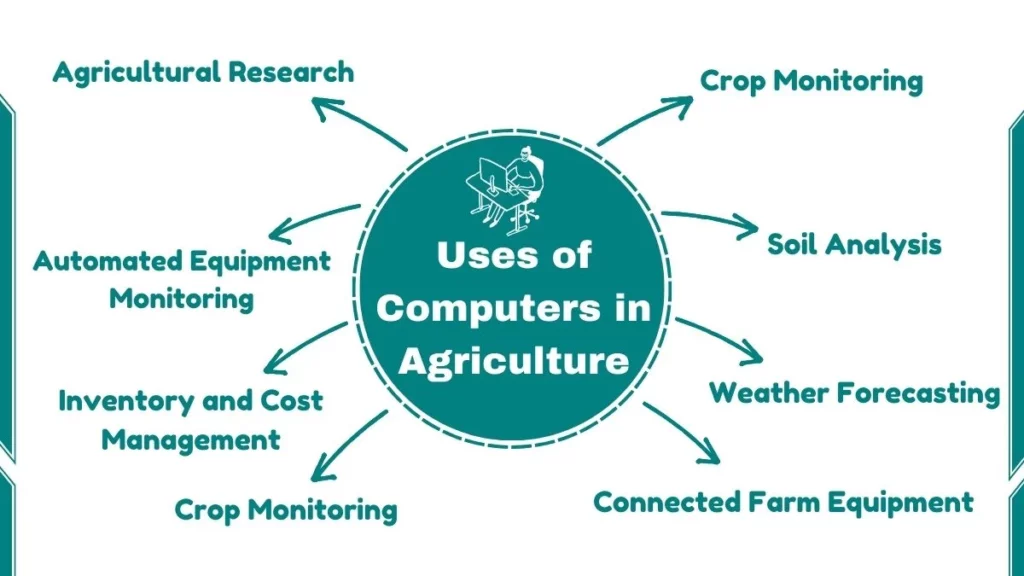Uses of computers in agriculture include Crop Monitoring and Management, Soil Analysis, Inventory and Cost Management, Agricultural Research, and more.
Computers have become an important part of agriculture and farming. From monitoring crop growth to analyzing soil conditions, computers provide numerous benefits for the agriculture industry.
Uses of Computers in Agriculture
Here are some uses of computers in the agriculture field:

1. Crop Monitoring and Management
Computers allow farmers to monitor their crops and automate many crop management tasks closely. Sensors and drones can provide real-time data on crop health, soil moisture, and pest/disease outbreaks.
Farmers can use this data to take preventative actions, like irrigating crops or applying pesticides. Software programs can also generate recommendations for fertilizer use, planting schedules, and harvesting timelines optimized for each field.
2. Soil Analysis
Detailed analysis of soil conditions is essential for productive farming. Computers analyze soil samples faster and more accurately than manual tests. Analysis software can examine nutrient levels, pH, and composition in detail.
It creates customized soil treatment and amendment recommendations to optimize conditions for specific crops. Computer modelling also helps predict the effects of different soil management practices.
3. Weather Forecasting and Modeling
Accurate weather information is important for agricultural planning and risk management. Computerized weather models use environmental data to forecast short and long-term weather patterns including precipitation, temperature, and wind.
This allows farmers to plan their crop selection, planting, pesticide application, and harvesting strategically. Weather modelling also helps with flood and drought preparation.
4. Navigation and Mapping
Computerized navigation displays and mapping software facilitate precise farming practices like soil sampling, planting, spraying, and harvesting. GPS guidance systems on tractors and other farm equipment enable efficient field coverage with minimal overlap and margins.
Field boundary maps help farmers monitor cropland and plan crop rotations. Soil sampling maps support zone-specific fertilizer and soil modification applications.
5. Robotic and Automated Equipment
Computers built into tractors, sprayers, harvesters, and other farm machinery automate field operations. These tools use sensors and GPS to steer equipment, adjust implements, and monitor crop conditions with minimal human intervention.
Farm robots can plant seeds, identify weeds, monitor livestock, and perform other repetitive chores reducing labour requirements.
6. Inventory and Cost Management
Extensive data collection and number crunching are required to manage operational costs and orders for seed, fertilizer, equipment, feed, veterinary supplies, etc.
Farm accounting software enables farmers to smoothly manage budgets, track expenses, monitor inventory levels, identify cost inefficiencies, and optimize purchasing. Market analysis reports help farmers make smart business decisions.
7. Animal Monitoring and Management
Specialized computer systems track livestock vitals like health, nutrition intake, growth, and stress levels. This supports protective care and optimized feeding schedules.
Dairy farm management software oversees milk production per cow. Poultry farm computers regulate the housing environment, feeding, and egg collection automatically. Such technology boosts production efficiency.
8. Decision Support Systems
Advanced agricultural decision support systems collect field data and historical records. Machine learning and advanced algorithms to generate real-time management recommendations personalized for individual fields and crops.
They provide guidance on best practices for planting dates, fertilizer application, problem management, harvest timing, and more. This enables farmers to leverage data insights for smarter decision-making.
9. Connected Farm Equipment
Interconnectivity between tractors, implements, sensors and farm computers provides seamless data sharing and automation across farm activities. Tractor-implement combinations can be managed as a single system, with coordination of speeds, implementation adjustments, and real-time reactions to field variability. This “connected farm” boosts efficiency and productivity.
10. Agricultural Research
Computers help agricultural research in many ways. Research institutions use supercomputers to analyze massive genomic datasets and model complex biological systems and chemical interactions.
Computer simulations help develop and test precision agriculture technologies. Statistical software analyzes data from lab and field observations. Research results are shared via online journals and databases. Overall, computers enhance the speed, efficiency, and impact of agricultural research.
Also Read:
